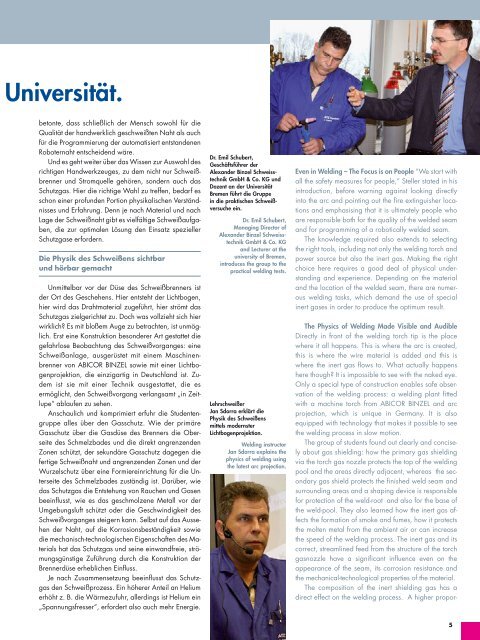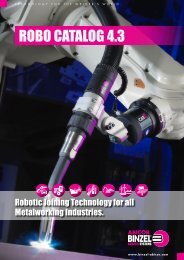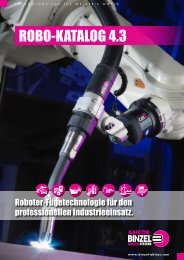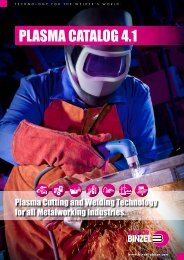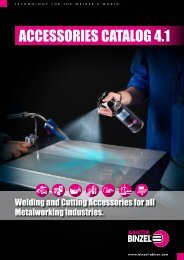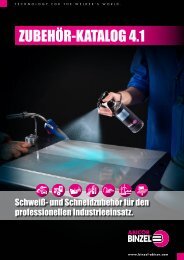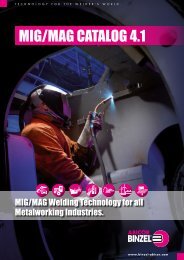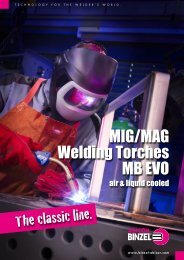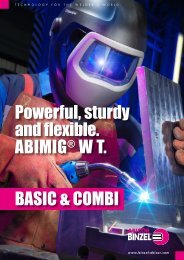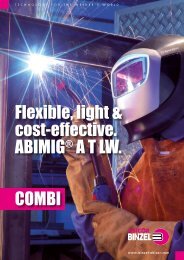Sie wollen auch ein ePaper? Erhöhen Sie die Reichweite Ihrer Titel.
YUMPU macht aus Druck-PDFs automatisch weboptimierte ePaper, die Google liebt.
Universität.<br />
betonte, dass schließlich der Mensch sowohl für die<br />
Qualität der handwerklich geschweißten Naht als auch<br />
für die Programmierung der automatisiert entstandenen<br />
Roboternaht entscheidend wäre.<br />
Und es geht weiter über das Wissen zur Auswahl des<br />
richtigen Handwerkzeuges, zu dem nicht nur Schweißbrenner<br />
und Stromquelle gehören, sondern auch das<br />
Schutzgas. Hier die richtige Wahl zu treffen, bedarf es<br />
schon einer profunden Portion physikalischen Verständnisses<br />
und Erfahrung. Denn je nach Material und nach<br />
Lage der Schweißnaht gibt es vielfältige Schweißaufgaben,<br />
die zur optimalen Lösung den Einsatz spezieller<br />
Schutzgase erfordern.<br />
Die Physik des Schweißens sichtbar<br />
und hörbar gemacht<br />
Unmittelbar vor der Düse des Schweißbrenners ist<br />
der Ort des Geschehens. Hier entsteht der Lichtbogen,<br />
hier wird das Drahtmaterial zugeführt, hier strömt das<br />
Schutzgas zielgerichtet zu. Doch was vollzieht sich hier<br />
wirklich? Es mit bloßem Auge zu betrachten, ist unmöglich.<br />
Erst eine Konstruktion besonderer Art gestattet die<br />
gefahrlose Beobachtung des Schweißvorganges: eine<br />
Schweißanlage, ausgerüstet mit einem Maschinenbrenner<br />
von ABICOR BINZEL sowie mit einer Lichtbogenprojektion,<br />
die einzigartig in Deutschland ist. Zudem<br />
ist sie mit einer Technik ausgestattet, die es<br />
ermöglicht, den Schweißvorgang verlangsamt „in Zeitlupe“<br />
ablaufen zu sehen.<br />
Anschaulich und komprimiert erfuhr die Studentengruppe<br />
alles über den Gasschutz. Wie der primäre<br />
Gasschutz über die Gasdüse des Brenners die Oberseite<br />
des Schmelzbades und die direkt angrenzenden<br />
Zonen schützt, der sekundäre Gasschutz dagegen die<br />
fertige Schweißnaht und angrenzenden Zonen und der<br />
Wurzelschutz über eine Formiereinrichtung für die Unterseite<br />
des Schmelzbades zuständig ist. Darüber, wie<br />
das Schutzgas die Entstehung von Rauchen und Gasen<br />
beeinflusst, wie es das geschmolzene Metall vor der<br />
Umgebungsluft schützt oder die Geschwindigkeit des<br />
Schweißvorganges steigern kann. Selbst auf das Aussehen<br />
der Naht, auf die Korrosionsbeständigkeit sowie<br />
die mechanisch-technologischen Eigenschaften des Materials<br />
hat das Schutzgas und seine einwandfreie, strömungsgünstige<br />
Zuführung durch die Konstruktion der<br />
Brennerdüse erheblichen Einfluss.<br />
Je nach Zusammensetzung beeinflusst das Schutzgas<br />
den Schweißprozess. Ein höherer Anteil an Helium<br />
erhöht z. B. die Wärmezufuhr, allerdings ist Helium ein<br />
„Spannungsfresser“, erfordert also auch mehr Energie.<br />
Dr. Emil Schubert,<br />
Geschäftsführer der<br />
Alexander Binzel Schweisstechnik<br />
GmbH & Co. KG und<br />
Dozent an der Universität<br />
Bremen führt die Gruppe<br />
in die praktischen Schweißversuche<br />
ein.<br />
Dr. Emil Schubert,<br />
Managing Director of<br />
Alexander Binzel Schweisstechnik<br />
GmbH & Co. KG<br />
and Lecturer at the<br />
university of Bremen,<br />
introduces the group to the<br />
practical welding tests.<br />
Lehrschweißer<br />
Jan Sdorra erklärt die<br />
Physik des Schweißens<br />
mittels modernster<br />
Lichtbogenprojektion.<br />
Welding instructor<br />
Jan Sdorra explains the<br />
physics of welding using<br />
the latest arc projection.<br />
Even in Welding – The Focus is on People “We start with<br />
all the safety measures for people,” Steller stated in his<br />
introduction, before warning against looking directly<br />
into the arc and pointing out the fire extinguisher locations<br />
and emphasising that it is ultimately people who<br />
are responsible both for the quality of the welded seam<br />
and for programming of a robotically welded seam.<br />
The knowledge required also extends to selecting<br />
the right tools, including not only the welding torch and<br />
power source but also the inert gas. Making the right<br />
choice here requires a good deal of physical understanding<br />
and experience. Depending on the material<br />
and the location of the welded seam, there are numerous<br />
welding tasks, which demand the use of special<br />
inert gases in order to produce the optimum result.<br />
The Physics of Welding Made Visible and Audible<br />
Directly in front of the welding torch tip is the place<br />
where it all happens. This is where the arc is created,<br />
this is where the wire material is added and this is<br />
where the inert gas flows to. What actually happens<br />
here though? It is impossible to see with the naked eye.<br />
Only a special type of construction enables safe observation<br />
of the welding process: a welding plant fitted<br />
with a machine torch from ABICOR BINZEL and arc<br />
projection, which is unique in Germany. It is also<br />
equipped with technology that makes it possible to see<br />
the welding process in slow motion.<br />
The group of students found out clearly and concisely<br />
about gas shielding: how the primary gas shielding<br />
via the torch gas nozzle protects the top of the welding<br />
pool and the areas directly adjacent, whereas the secondary<br />
gas shield protects the finished weld seam and<br />
surrounding areas and a shaping device is responsible<br />
for protection of the weld-root and also for the base of<br />
the weld-pool. They also learned how the inert gas affects<br />
the formation of smoke and fumes, how it protects<br />
the molten metal from the ambient air or can increase<br />
the speed of the welding process. The inert gas and its<br />
correct, streamlined feed from the structure of the torch<br />
gasnozzle have a significant influence even on the<br />
appearance of the seam, its corrosion resistance and<br />
the mechanical-technological properties of the material.<br />
The composition of the inert shielding gas has a<br />
direct effect on the welding process. A higher propor-<br />
5


